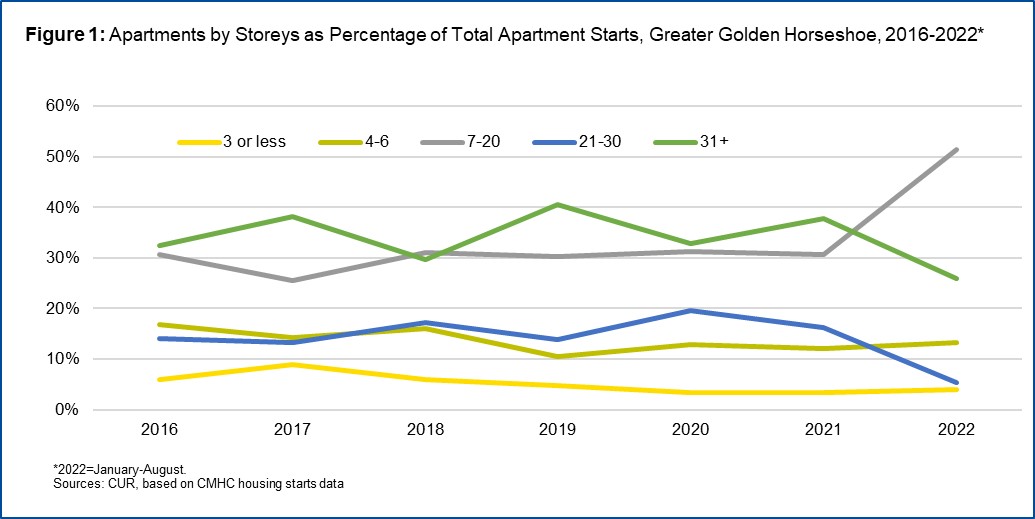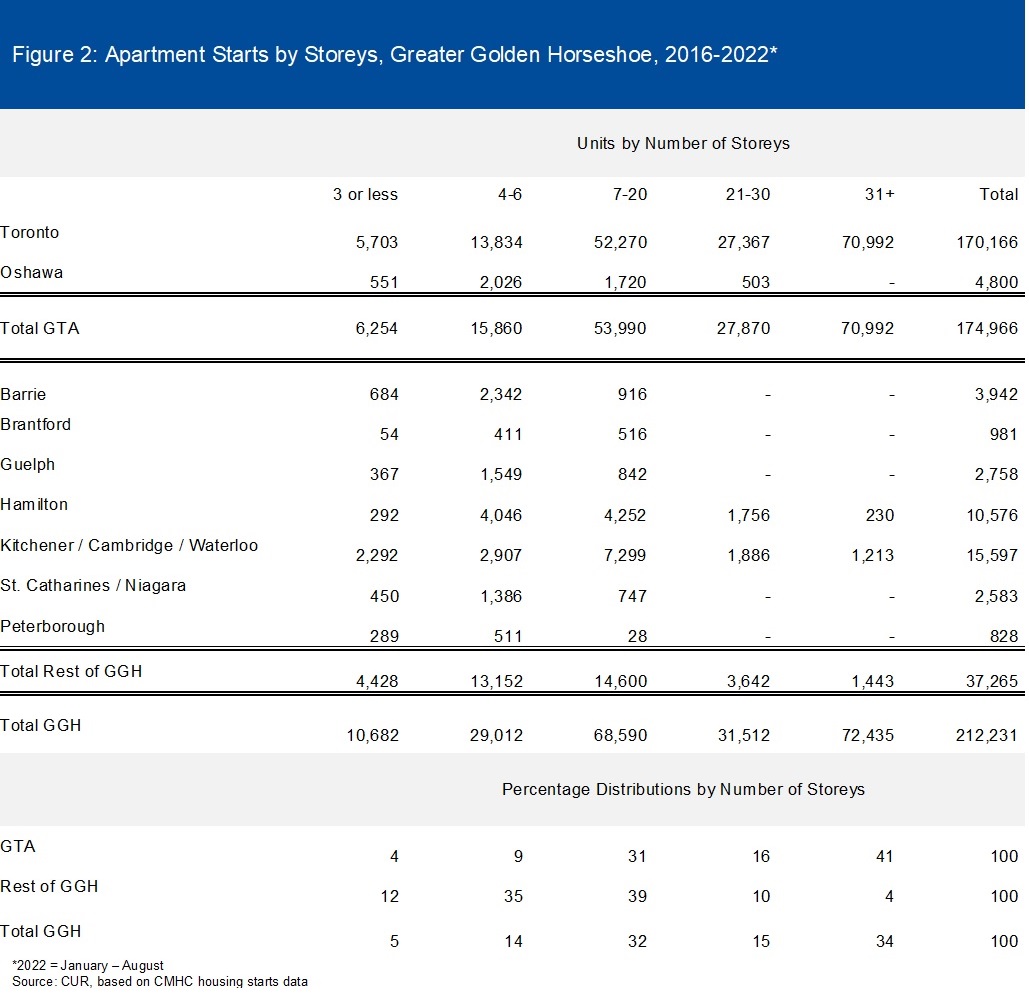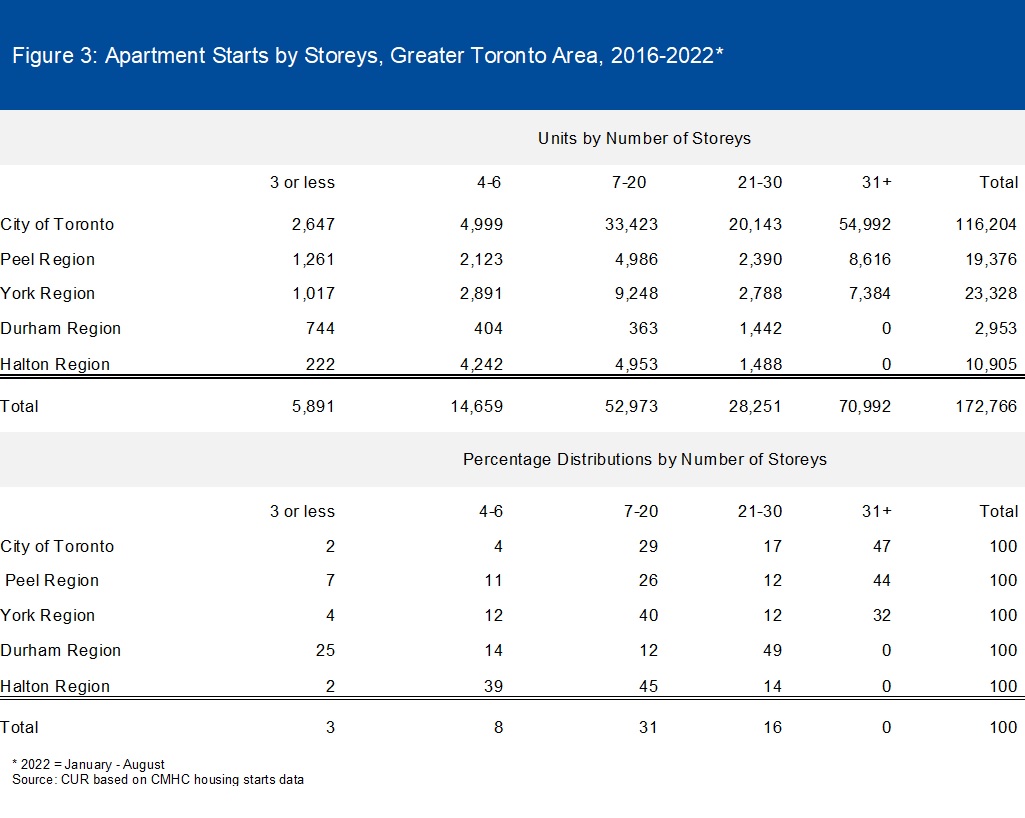Missing in Action: New Low-Rise Apartments in the Greater Golden Horseshoe
By: Frank Clayton and Graeme Paton, TMU CUR
November 10, 2022
(PDF file) Print-friendly version available
Summary
This paper examines unpublished CMHC data to analyze the number of low-rise apartments (“missing middle”) being constructed in the Greater Golden Horseshoe (“GGH”). It also briefly considers whether this production is sufficient to fill the gap created by the past undersupply of new ground-related housing (single- and semi-detached houses and townhouses). Missing middle housing encompasses housing types that fall between a single-detached or semi-detached house and a high-rise apartment building (defined as five or more storeys).1 Low-rise apartments, including stacked townhouses, remain a lower-priced option for buyers desiring a home with access from the ground level or near-ground access.2
This analysis of CMHC apartment starts data shows that the construction of lower-rise missing middle apartments in the GGH falls considerably short of the units required to offset the under-production of market-based ground-related housing as well as latent demand, whether these starts are approximated by units in structures of three or six storeys or less. CMHC’s breakdown of starts in lower-rise apartment structures (three or fewer and four to six storeys) is at odds with the Census of Canada (four or fewer storeys).
Highlights include:
- Missing middle starts are a small share of GGH apartment starts, and their share declined from 2016 to 2022:
Missing middle averaged just 5% (three or fewer storeys), or 14% (six or fewer storeys) of apartment starts in this period;
- Missing middle as a percentage of all apartment starts was between three and four times higher in the Census Metropolitan Areas (“CMAs”) outside the Greater Toronto Area (“GTA”); and
- Only 6% of the apartment starts in the City of Toronto were in buildings of six storeys or less.
This small number of missing middle apartment starts, combined with a robust latent demand, points to the need for an explosive increase in the construction of these apartments in the city. The most obvious way of achieving this is the up-zoning of existing single-family housing neighbourhoods.
Background
There is potential for “missing middle” housing in the Greater Golden Horseshoe (“GGH”) to provide more affordable, family-friendly accommodation, given the stratospheric prices of single-detached and semi-detached houses. Even townhouses, the closest substitute to single-detached and semi-detached houses, are now out of reach for many buyers in the region. Low-rise apartments including stacked townhouses remain the next lowest-priced option for buyers desiring a home with access from the ground level or near-ground access. The failure to build enough low-rise apartments in response to provincial-directed land use planning curbs on the building of ground-related homes will result in higher housing costs and longer commutes as households move further away from employment centres in search of less expensive ground-related homes.3
This paper analyzes the number of new missing middle units built since 2016 and their location in the GGH. In addition, it addresses the potential of missing middle apartment housing to fill the gap created by the past underproduction of ground-related housing (single- and semi-detached houses and townhouses).
An estimate of the shortfall in the production of ground-related housing in the GGH using a market-based approach to housing requirements estimates a gargantuan shortfall of 180,277 ground-related homes in the 15 years from mid-2006 to mid-2021.4 That study also found that the surplus production of all apartments (not only missing middle apartments) fell well short of filling this shortfall.
Description of source data
In recent years, CMHC has been collecting information on the number of storeys in apartment structures as part of its monthly survey of housing starts and completions, but the data are not regularly released.
CUR submitted a request to CMHC for data on missing middle starts across all GGH municipalities, specifically looking at annual data for 2016 to 2021 and January-August for 2022. CMHC groups the data into five ranges, but unfortunately, the lowest grouping is not the same as the Census of Canada (three storeys or less rather than four storeys or less). Given this discrepancy, missing middle apartments are approximated in two ways: using three storeys or less and six storeys or less.
Two geographic combinations are assessed: the GGH, which is approximated by its nine CMAs and the GTA, consisting of Toronto and the four regional municipalities – Durham, Halton, York and Peel.
GGH missing middle apartments by year: small supply, no upward trend
Figure 1 depicts the percentage of total apartments starts by number of storeys for the GGH between 2016 and 2022 to August.

Summary of findings:
- Missing middle starts are a small share of GGH apartment starts, and this share declined from 2016 to 2022 whether measured by structures three storeys or less or six storeys or less
The production of apartments in building three storeys or less declined from nearly 10% of apartment starts in 2017 to less than 5% in 2020-2022. Starts of units in buildings having four to six storeys also experienced a slight decline from 17% in 2016 to 10-12% in 2019-2022. Looking at both size groups together, fewer than one in five apartments starts were in buildings of six storeys or less in most years.
- Most new apartments are built in structures 31 storeys or more and 7-20 storeys
The CMHC data suggests a bifurcated split in taller buildings with the 31+ storeys and 7-20 storey groupings accounting for the bulk of apartments starts - 30-40% and around 30%, respectively. The smaller share of starts in buildings sized 21-30 floors could be because this group of buildings encompasses a range of nine storeys versus 14 storeys for the 7-20 group.
The sharp decline in the relative share of units in buildings of 21-30 storeys and the corresponding rise in units in 7-20 storey buildings during the first eight months of 2022 is considered an aberration.
GGH missing middle apartments by CMA: relatively more common outside the GTA
Figure 2 tabulates the number of apartment starts by storeys for the nine GGH CMAs for 2016-2022. The lion’s share of apartment construction was in the Toronto CMA, with 170,166 starts, accounting for 80% of the GGH. Kitchener/Cambridge/Waterloo and St. Catharines/Niagara were far behind with 15,597 and 2,583 apartment starts, respectively.

Summary of findings:
- Missing middle as a proportion of apartment starts are highest in the GGH outside the GTA
Nearly half of the apartments starts in the GGH, excluding the GTA, were in buildings of six storeys or less in 2016-2022 (47%). This compares with just 13% of apartment starts in the GTA. Most of these starts were in buildings of four to six storeys (35%), with the remainder (12%) in buildings three storeys or less.
- For CMAs, Toronto and Kitchener have the most significant unit counts of new missing middle apartments in buildings of three storeys and less
Of the 10,682 apartments in buildings of three storeys or less in the GGH starts during2016-2022, the greatest numbers were in the Toronto and the Kitchener/Cambridge/Waterloo CMAs (5,703 and 2,292, respectively).
- For CMAs, Toronto, Hamilton, Kitchener, Barrie, and Oshawa have the most apartment starts in buildings of four to six storeys
With 13,834 starts of units in buildings of four to six storeys, the Toronto CMA was tops in absolute numbers. Hamilton was next, with 4,046 starts between 2016 and 2022.Kitchener/Cambridge/Waterloo, Barrie and Oshawa all had starts in the 2,000-3,000range.
GTA missing middle apartment starts by municipality: Durham and Halton Regions are the leaders
Figure 3 depicts where missing middle apartments are being built by municipalities (upper-tier and single-tier) within the GTA.
Summary of findings:
- Durham and Halton Regions have the highest proportion of missing middle in their apartment starts
Just two municipalities had sizable contingents of missing middle housing in their apartment starts. Durham Region had 25% of its starts in structures of three storeys or less and 39% in structures of six storeys or less. Halton Region, in contrast, had only 2%of its apartments starts in buildings of three stories or less but 41% in buildings of six storeys or less.
- In unit counts, Durham was the laggard among GTA municipalities
Durham Region lagged behind the other municipalities in the number of missing middle apartments because it had relatively few apartment starts from 2016 to 2022. The City of Toronto, followed by Peel and York Regions, had the most apartments starts in three storeys or fewer structures, but the numbers were small. Looking at apartments in structures of six or fewer storeys, Halton Region had starts closest to the City of Toronto (4,464 vs. 7,646) followed by York and Peel Regions (3,908 vs. 3,384).

Conclusion
The analysis of CMHC apartment starts data shows that the construction of low-rise missing middle apartments in the GGH, defined as buildings of three storeys or less or six storeys or less, falls considerably short of the units required to offset the under-production of market-based ground-related housing as well as the inherent demand for low-rise apartments.
Only 6% of the apartment starts in the City of Toronto were in buildings of six storeys or less. This small number of missing middle apartment starts in the City of Toronto, combined with a robust latent demand, points to the need for an explosive increase in the construction of these apartments in the city. The most obvious way of achieving this is the up-zoning of existing single-family housing neighbourhoods.
Footnotes:
[1] The definition of missing middle housing used by CUR approximates the definition coined by American Architect Daniel Parolek where “missing middle housing” includes housing unit types that fall between a single-detached or semi-detached house and a high-rise apartment building (defined as having five or more storeys). For details of missing middle housing based upon Census of Canada data see: Frank Clayton & Diana Petramala (2019). ‘A Strategy for Significantly Increasing the Supply of “Missing Middle” Housing in the City of Toronto.’ Centre for Urban Research and Land Development. [Online] Available: (PDF file) https://www.torontomu.ca/content/dam/centre-urban-research-land-development/pdfs/TREB/CUR_Missing_Middle_Housing_Toronto.pdf, 9-10
[2] Ground-related homes include single- and semi-detached houses and townhouses.
[3] Frank Clayton (2022). “GTHA 2021-2051 Land Needs Forecasts Lack Viable Alternatives to Single-Detached Houses.” Centre for Urban Research and Land Development. [Online] Available: (PDF file) https://www.torontomu.ca/content/dam/centre-urban-research-land-development/CUR_Land_Needs_GGH_and_Missing_Middle_Aug.2022.pdf., 8-9.
[4] Will Dunning (2022). “Housing Production in Canada Has Fallen Far Short of the Needs of Our Growing Population.” [Online] Available: (PDF file) https://www.wdunning.com/_files/ugd/ddda71_58e2ddbb75914a1188a6377e71c696c1.pdf (external link) , 10.
Frank Clayton, Ph.D., is Senior Research Fellow at Toronto Metropolitan University’s Centre for Urban Research and Land Development (CUR) in Toronto.
Graeme Paton, B. Comm, is Research Assistant at Toronto Metropolitan University’s Centre for Urban Research and Land Development (CUR) in Toronto.